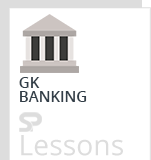 Introduction
Introduction
Banking Awareness is an important section in the employment-related competitive exams in India. In particular, exams like IBPS, SBI and other bank-related employment exams have banking awareness questions along with the general awareness section. The Banking Awareness section primarily has questions related to the History of Banking, Banking Terms, Banking Products, Functions of Banks, Banks and their Taglines, Schemes, Committees related to Banking, Headquarters of Banks, most recent Banking News, Apps launched by Banks, New Schemes, Monetary Policies, etc.
Banking Awareness Quiz 57 article provides the list of several bank-related questions to prepare aspirants of different competitive exams in India, primarily for banking-related employment. The article Banking Awareness Quiz 57 is very useful for different exams such as IBPS PO, Clerk, SSC CGL, SBI PO, NIACL Assistant, NICL AO, IBPS RRB, Railways, Civil Services, etc.
 Quiz
Quiz
Q1. In India, Mutual Funds are regulated by-?
-
A. Securities and Exchange Board of India
B. Reserve Bank of India
C. State Bank of India
D. Small Industrial Development Bank of India
E. None of the given options is true
-
A. Identify a person
B. To know the address of a person
C. To ensure the genuineness the person’s identity as mentioned in the application and to verify the correctness of address
D. Concern state government
E. None of the given options is true
-
A. Magnetic Ink Character Recognition
B. Maximum Individual Cancer Risk
C. Michigan Incident Crime Reporting
D. Magnetic Ink Check Reader
E. None of the given options is true
-
A. All financial institutions
B. Only by Commercial Banks
C. Only by Common Banks
D. Indian Government
E. None of the given options is true
-
A. State Bank of India
B. Canara Bank
C. Punjab National Bank
D. Bank of India
E. Bank of Baroda
Q1. Who can invest in a commercial paper?
-
A. Individuals
B. Banking Companies
C. Corporate bodies registered or incorporated in India and unincorporated bodies, Non- Resident Indians (NRIs) and Foreign Institutional Investors (FIIs)
D. All of the above
E. None of the given options is true
-
A. Vaz Committee
B. Cooks Committee
C. Basel Committee
D. Rao Committee
E. None of the given options is true
-
A. 1% above Repo Rate
B. 0.25% below Repo Rate
C. Same as Repo Rate
D. 1% below Repo Rate
E. 0.25% above Repo Rate
-
A. ICICI Bank
B. Syndicate Bank
C. Axis Bank
D. HDFC Bank
E. State Bank of India
-
A. Bank Rate
B. Repo Rate
C. Reverse Repo Rate
D. Prime Lending Rate
E. None of the given options is true
Q1. Which of the following is NOT a function of the Reserve Bank of India?
-
A. Fiscal Policy Functions
B. Exchange Control Functions
C. Issuance, Exchange and destruction of currency notes
D. Monetary Authority Functions
E. Supervisory and Control Functions
-
A. Will
B. Registration
C. Nomination
D. Indemnity
E. Guarantee
-
A. Minors
B. Married women
C. Senior citizens
D. Govt. employees
E. Rural residents
-
A. Introduction of GST.
B. The stimulus for the agriculture sector
C. Concessions for foreign investment
D. Tightening of monetary policy
E. None of the given options is tru
-
A. Single
B. Small
C. Special
D. Savings
E. Separate



